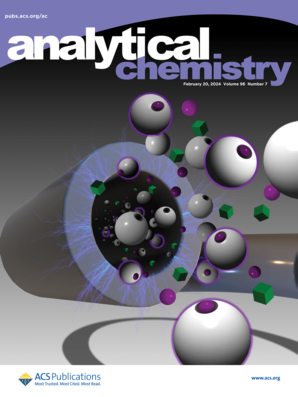A Novel Afterglow Molecular Probe for Monitoring of pH and Viscosity in Infected Wounds with Two-Dimensional Signal
IF 6.7
1区 化学
Q1 CHEMISTRY, ANALYTICAL
引用次数: 0
Abstract
Organic afterglow materials have shown tremendous potential in the field of biomedical imaging. However, reports on small-molecule afterglow probes, particularly those with multitarget detection capabilities, remain limited. Here, we report a novel afterglow molecule probe (Hcy-Br-SO) that effectively responds to changes in pH and viscosity during wound infection, based on a two-dimensional (2D) signal. In this design, the enhancement of molecular afterglow performance was achieved through molecular engineering, and the underlying mechanism of afterglow emission was derived. Additionally, the synergistic enhancement of the afterglow intensity of Hcy-Br-SO by the increase in the pH and viscosity was confirmed. Besides, we observed that viscosity could retard the photoreaction process, thereby extending the duration of afterglow emission. Based on this phenomenon, we transformed the traditional time-dependent characteristics of afterglow into a measurable parameter for monitoring viscosity changes. It is noteworthy that the introduction of the time dimension not only facilitates the separation of signal sources but also explores the application potential of afterglow molecular probes. To the best of our knowledge, this is the first afterglow small-molecule probe that uses 2D signals (intensity and half-life) to monitor binocular targets. Furthermore, the Hcy-Br-SO probe was successfully used to distinguish between normal and infected wounds. This work may be useful to unravel the pathological mechanisms of chronic wounds and provide guidance for intervention.

一种新型余辉分子探针用于监测感染创面pH和粘度的二维信号
有机余辉材料在生物医学成像领域显示出巨大的潜力。然而,关于小分子余辉探针的报道,特别是那些具有多目标检测能力的,仍然有限。在这里,我们报告了一种新型的余辉分子探针(Hcy-Br-SO),它基于二维(2D)信号,有效地响应伤口感染期间pH和粘度的变化。在本设计中,通过分子工程实现了分子余辉性能的增强,并推导了余辉发射的潜在机理。此外,还证实了pH和粘度的增加对Hcy-Br-SO的余辉强度有协同增强作用。此外,我们观察到黏度可以延缓光反应过程,从而延长余辉发射的持续时间。基于这一现象,我们将传统的随时间变化的余辉特性转化为监测粘度变化的可测量参数。值得注意的是,时间维度的引入不仅方便了信号源的分离,而且探索了余辉分子探针的应用潜力。据我们所知,这是第一个使用二维信号(强度和半衰期)来监测双目目标的余辉小分子探针。此外,Hcy-Br-SO探针成功地用于区分正常和感染伤口。这项工作可能有助于揭示慢性创伤的病理机制,并为干预提供指导。
本文章由计算机程序翻译,如有差异,请以英文原文为准。
求助全文
约1分钟内获得全文
求助全文
来源期刊

Analytical Chemistry
化学-分析化学
CiteScore
12.10
自引率
12.20%
发文量
1949
审稿时长
1.4 months
期刊介绍:
Analytical Chemistry, a peer-reviewed research journal, focuses on disseminating new and original knowledge across all branches of analytical chemistry. Fundamental articles may explore general principles of chemical measurement science and need not directly address existing or potential analytical methodology. They can be entirely theoretical or report experimental results. Contributions may cover various phases of analytical operations, including sampling, bioanalysis, electrochemistry, mass spectrometry, microscale and nanoscale systems, environmental analysis, separations, spectroscopy, chemical reactions and selectivity, instrumentation, imaging, surface analysis, and data processing. Papers discussing known analytical methods should present a significant, original application of the method, a notable improvement, or results on an important analyte.
 求助内容:
求助内容: 应助结果提醒方式:
应助结果提醒方式:


